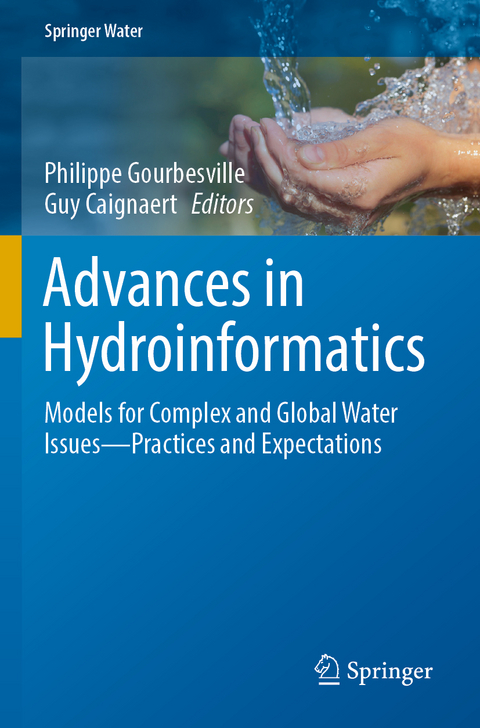
Advances in Hydroinformatics
Springer Verlag, Singapore
978-981-19-1602-1 (ISBN)
Local downscaling of shallow water simulations.- SW2D-LEMON: a new software for upscaled shallow water modelling.- 1D numerical tool for real time modelling of a complex river network.- Rapid simulations of large scale flood inundations using porosity functions.- Numerical and methodological developments in 1D+ ISM models for operational purposes.- Application of a modified parareal method for speeding up the numerical resolution of the 2D shallow water equations.- Validation of a general-purpose erosion-sedimentation model on a laboratory experiment.- Modelling culverts in Basilisk.- Uncertainty quantification in hydrodynamic modelling using the example of a 2D large-scale model of the River Elbe.- Quantification of historical skew surges : challenges and method.- Sensitivity analysis of the digital twin of the canal of Calais to the outlet gate modelling.- Integrated hydraulic-hydrological assimilation chain: towards multisource data fusion from river network to headwaters.- Meandering of the Venoge River at Bois-de-Vaux: in-situ measurements versus 2D numerical predictions.- How to optimally represent riverbed geometry with a simplified cross-section shape in shallow water models?.- Evaluate the influence of groynes system on the hydraulic regime in the ha thanh river, binh dinh province.- Comparison of streamflow estimated by image analysis (LSPIV) and by hydrologic and hydraulic modelling on the French Riviera during 2019 floods.- Analysis of Triple Rectangular Plates Configurations Impacts on Local Scour around Cylindrical Single Bridge Pier.- 2-D simulation of flow entering a building.- Investigation of the hydraulics in flooded housing estate..- Benefit of coupling 1d-2d model over an urban area to assess runoff during a storm event.- Stream Rehabilitation Design In A Potentially Protected Forest Catchment In Singapore.- Application of a physics based distributed integrated hydrological model in flood risk management.- Risk Analysis for Flash Flood Hazards in China.- Determination and application of dynamic rainfall threshold for flash flood warning.- Optimized Reservoir Prior Release Operation for Flood Control Considering Operational Weekly Ensemble Hydrological Forecast.- Geographical cluster of flash flood hazards in Jiangxi, China: a spatial analysis perspective.- Analysis of extreme precipitation during the Mediterranean event associated with the Alex storm in the Alpes-Maritimes: atmospheric mechanisms and resulting rainfall.- Are hydrologic-hydraulic coupling approaches able to reproduce Alex flash-flood dynamics and impacts on southeastern French headwaters?.- Improving the efficiency of Flash Flood Forecasting and Warning System in Thailand.- Study on Forecasting and Alarming Model of Flush Flood Based on Machine Learning.- Numerical assessment of sediment supply impacting flash flood propagation in mountainous confluences.- Wood debris risk analysis and protection scenarios of Lourdes city using Iberwood model.- A study onflood inundation mapping of surma river floodplain under extreme flood scenario nature based solutions.- A framework for evaluating performance of large-scale Nature-Based Solutions to reduce hydro-meteorological risks and enhance co-benefits.- Managing droughts in Northern Germany Ð The RECONECT NBS Approach and Water resources model for Vier- und Marschlande Area, Hamburg, Germany.- Opportunities and challenges of Natural-Based Solutions in urban areas - French case studies.- The 1915 mud-debris flow at san fruttuoso di camogli: modeling the collapse effects in the portofino pilot area of the h2020 reconect project.- Benefits of green infrastructure for flood mitigation in small rural watersheds - Case study of the Tamnava River in Serbia.- Modelling Nature-Based Solutions with quasi-2D model.- Bregana river basin: hydrodynamic modeling and analysis of nbs suitability within the reconect project.
| Erscheinungsdatum | 10.10.2023 |
|---|---|
| Reihe/Serie | Springer Water |
| Zusatzinfo | 742 Illustrations, color; 67 Illustrations, black and white; XVIII, 1245 p. 809 illus., 742 illus. in color. In 2 volumes, not available separately. |
| Verlagsort | Singapore |
| Sprache | englisch |
| Maße | 155 x 235 mm |
| Themenwelt | Naturwissenschaften ► Biologie ► Ökologie / Naturschutz |
| Naturwissenschaften ► Geowissenschaften ► Geografie / Kartografie | |
| Naturwissenschaften ► Geowissenschaften ► Hydrologie / Ozeanografie | |
| Schlagworte | Big Data • Computational Hydraulics • Hydraulic Machinery • hydroinformatics • Inundation Modeling • Marine Hydraulics • Marine Models • SimHydro 2021 • Urban Flood Modeling • Urban Hydraulics • Water Management |
| ISBN-10 | 981-19-1602-0 / 9811916020 |
| ISBN-13 | 978-981-19-1602-1 / 9789811916021 |
| Zustand | Neuware |
| Haben Sie eine Frage zum Produkt? |
aus dem Bereich


